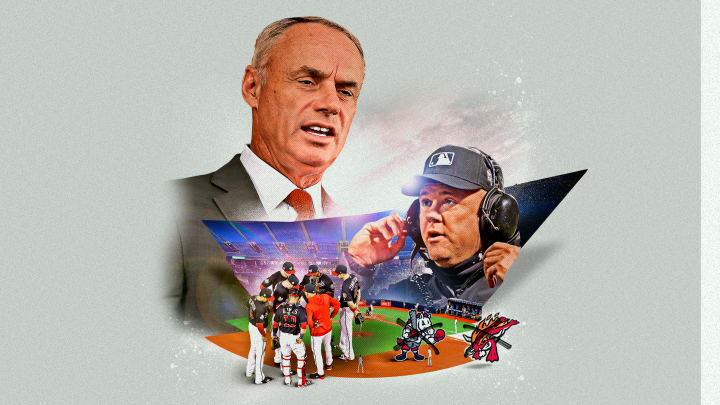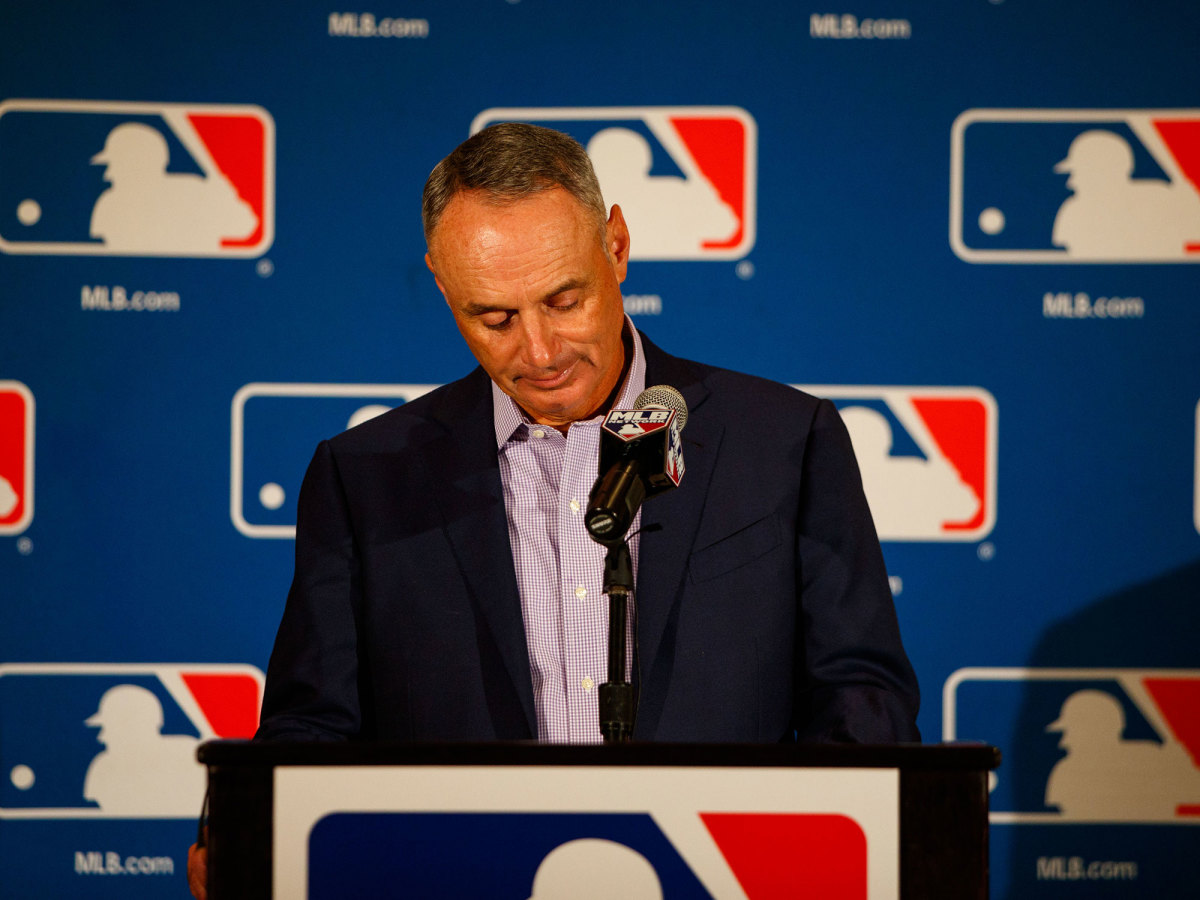Rob Manfred Knows It's Time for Him to Act

Through the mammoth windows of his new seventh-floor corner office in midtown Manhattan, MLB commissioner Rob Manfred has a box seat to the world. The Radio City Music Hall marquee glows across the street, headlines crawl in formation on the electronic ticker at Fox News headquarters two blocks away and the Freedom Tower stands sentry over the world’s commercial center a few miles south. Yet Manfred can be forgiven for not looking up from the issues upon his desk, such are their weight and number.
He succeeded Bud Selig in January 2015. On the fifth anniversary of his tenure—the beginning of a second five-year term owners gave him in 2018—the Harvard-trained lawyer, 61, was dealing with two sign-stealing scandals, public skepticism about a juiced baseball, declining attendance, a slowing pace of play, pushback to his proposed culling of the minor leagues and a looming CBA negotiation with a restive union.
In his first five years on the job, Manfred changed the oil at regular intervals and kept the machine running. Revenues last year rose for a 17th straight year, to $10.7 billion. As technology changed how the game was played, Manfred showed a penchant for spitballing—Ban the shift? Implement a pitch clock? Bonus baserunners in extra innings?—but he did more thinking than tinkering. (Two notable Manfred changes will slightly affect the game in 2020: Relief pitchers must either finish the inning in which they enter or face a minimum of three batters, up from the previous requirement of one, and regular roster sizes have grown from 25 players to 26. But in September, when rosters usually expand to 40, they will now go to 28.)
Those days are over. It is time for Manfred to act, and he knows it. He must decide on the kind of game he wants to shepherd. Baseball will change far more in the next five years than it did in the previous five.
Advanced media, international growth, higher ticket prices and streaming have kept revenues growing, but the game’s aesthetics are losing appeal in a faster world. Time of game under Manfred has increased by 10 minutes, to a record 3:10. The added length derived entirely from more dawdling between pitches—24.9 seconds, up from an average of 22.7 in 2015. As the number of strikeouts, pitches and pitching changes rose each of the past five years, so did the amount of time between balls in play. The formula of less action over a longer period turned off fans. From 2015 to ’19, attendance dropped by 5.2 million, or 2,151 fans per game.

One of the game’s greatest appeals has been the natural time and space it provides for rumination and anticipation, but those who have grown up with readily available technological distractions abhor such voids. As Manfred said of enjoying a round of golf, “I don’t want to take an Instagram of myself on the third hole. I want to get away. In contrast, [younger fans] like to think, ‘This is my big event.’ And we need to take each of our 81 home games and make each one a big event for fans to continue to get them to come to the ballpark.”
Before working on the game’s aesthetics, though, Manfred has some more pressing concerns and targets, which he shared with Sports Illustrated in a January interview.
Crack down on the misuse of technology
With investigations into sign-stealing scandals involving two of the past three world champions (the 2017 Astros and ’18 Red Sox) Manfred put the onus squarely on GMs, managers and coaches, not players.
“I’m not interested in ‘other people were doing it’ as a defense,” he said. “If other people were doing it, give me the information and I’ll investigate it. If we buy into the idea that you can justify your own conduct [because] somebody else was engaged in it, we have chaos. And we’re not going to have chaos as long as I’m sitting here.”
Paranoia about sign-stealing has contributed to the slowing down of play. Manfred said a “longer-term” solution may come through technology that changes how catchers give signs such as a series of lights embedded in the pitching rubber. In the interim he is considering closing all in-game video access except for the replay monitor, which is manned by MLB security. “That’s the first path,” he said. “It is an option.”
Adopt an automated strike zone
Umpires fitted with earpieces will signal ball or strike based on ball-tracking technology. Based on minor league trials, MLB most likely will have to redefine the strike zone from its current three-dimensional pentagon to a two-dimensional plane at the front of the plate. Such a system may be adopted as soon as 2022.
“I think we will see it,” Manfred said. “A hundred percent. I think it will be good for the game.”
Prioritize the CBA over a pitch clock
Manfred once threatened to implement a pitch clock but backed down, fearing it would damage labor relations if players weren’t on board first. For the most part, they’re not. “Change on this topic has proved more difficult than I anticipated,” Manfred said.
Accept some variability in ball performance
According to Manfred, MLB will add “two or three” humidors this year in ballparks to the existing ones in Colorado and Arizona “to collect some data on how changes in humidity affect [ball] performance.”
A baseball must be hand-sewn, as no machine has mastered the intricacy of the last stitch. “The more I think about it, the more I am convinced of two things,” he said. “We should understand as much as we can, but at the end of the day we have to accept the reality there is going to be some variability in the performance of the baseball.
“What you would see with a non-handmade product would be shocking to most baseball fans. It would look different, it would feel different, it would play different. I know people think I have an app here on my phone and decide how it’s going to perform in a particular year. If you have a machine-made baseball, literally somebody needs to decide every year how it is going to play.”
Embrace gambling—with limits
“You may see parlors [in ballpark], but I don’t think you’re going to see [betting] windows,” he said. “Maybe this is Rob Manfred entering his second term naïve, but I do believe that the atmosphere at our ballparks would change with parimutuel windows.”
As for putting betting information on broadcasts, he said, “I can see a separate feed being much more aggressive in terms of what you see on the screen for those who are really interested but that would be a supplement to our core family product.”

Revamp the minor league system
MLB has proposed cutting the affiliations of 42 minor league teams in order to reduce travel and improve facilities. Opponents of Manfred’s proposal consider it an affront to some communities with long minor league histories (not to mention recently upgraded stadiums) and a tactic to keep down aggregate labor costs amid mounting public pressure to pay minor leaguers more.
“I don’t think they should blame me for wanting to have decent working conditions for our employees,” he said. “At the end of the day we will not save one dime. Even if we went out and got rid of all 42 of them, what we would have to spend in order to get the improvements I want in the existing places it would probably cost us money. When we’re talking about profit, I’m not shy about it—this is not about making more money.”
Resolve stadium issues before expanding
Owners want two expansion teams in part because scheduling is far easier with 16-team leagues. But Manfred says baseball will not expand until the Athletics and Rays secure plans for new ballparks—somewhere.
“One hundred percent,” he said. “Resolved one way or another. I’m not looking to make news here, but we’ve been at it a long time in both places. We’ve shown some great loyalties to the existing cities. I hope that loyalty pays off by getting something done. But something needs to get done in both places.”
Choose a preferred emerging market
MLB sponsors baseball in 450 schools in India and China. “I think at some point we’re going to have to make a decision where we allocate more chips,” he said.
In the meantime, Manfred plans more regular season games in Europe, Mexico and the Far East.
Consider changes to regular and postseason scheduling
“I think I’m fortunate,” Manfred said, “in that I have a group of owners without exception that recognizes the need to be open-minded to those kinds of changes over the next five years.”
All of those issues leave Manfred with a pretty full plate—and yet he answered quickly with another problem when asked to identify his biggest challenge. “[It’s] the next generation—in terms of consumption habits, both live and in media.”
What is it about potential young consumers that most worries the commissioner? “Their attention span,” he said. “My kids are actually older than what I’m really worried about, because they’re 26 to 34. But I watch even them. The idea of sitting down and watching a two-hour, 30-minute movie is different for them than it is for me. The [younger they are], the more of a challenge it is.”
Technology created the greatest changes in baseball in Manfred’s first five years. The next five will bring far more. It’s up to Manfred to make sure the sport doesn’t lose this hyper-engaged generation.
This story appears in the February 2020 issue of Sports Illustrated. To subscribe, click here.
